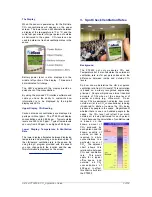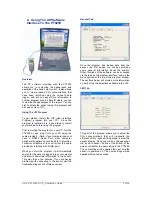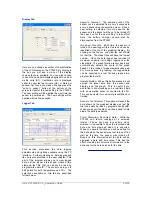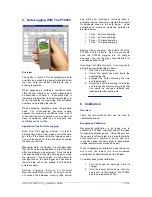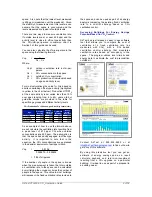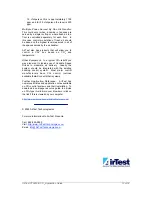
AirTest PT9250 & CO
2
Application Guide
8 of
12
3. Leave the sensor in place for at least 5
hours.
4. When the background calibration period
is complete hold the power button down
to power off the hand held unit.
5. Once powered on (restarted), the
sensor is ready to use.
The maximum correction the sensor will make in
a 5 hour period is 130 ppm, If you suspect the
sensor is significantly out of calibration you may
have to perform a number of background
calibrations.
UIP Based Calibration
By using the capabilities of the UIP software
program you can quickly (approximately 5
minutes) calibrate the sensor to a known source
of CO
2
. Using the UIP program you can perform
a quick background calibration, a zero calibration
and a span calibration. You can also calibrate
the temperature sensor if desired. The process
for each type of CO
2
calibration is very similar.
1. Expose the sensor to a known
concentration of gas either using
ambient concentrations or by flowing
calibration gas through the calibration
port on the bottom of the sensor.
2. Go to the “Sensor” heading on the
program menu bar and select
‘calibration’.
3. Choose the type of calibration you
would like to perform: Background,
Zero Cal, Span Cal or Temperature Cal.
4. A series of menus will lead you through
the calibration process for the type of
calibration you wish to perform.
Application Tips
Calibration Gas:
Calibration gases, tubing and
regulators are available from AirTest.
Zero & Span Calibration:
Typically, drift of the
PT9250 is on the zero adjustment of the sensor.
The sensor generally should not require span
adjustment. If performing both types of
calibration the zero calibration should be
performed first.
7. Making Most Of The TR9250 –
Some Application Examples
Overview:
This section provides a brief description of a
number of real world applications for the PT9250
hand held.
Estimating Ventilation Rate From A Data
Logged Sample:
Data logged over time samples have a great
advantage over a spot measurement.
•
You can get a clear profile of ventilation
in the space over the course of a day,
week or more.
•
It is possible to determine the peak
value that will determine what the
cfm/person ventilation rate is.
•
You can determine if occupancy and
use patterns are consistent over an
extended period of time.
•
The data logged sample provides an
excellent tool for comparing before and
after ventilation performance, for
example, after retrofit work has been
undertaken.
The chart below shows data logged temperature
and CO
2
concentrations in an office space that
were recorded on the PT9250, downloaded to a
text file, and then graphed using the charting
capabilities in Excel®. The charting capabilities of
this and other spreadsheet programs offer
tremendous versatility in customizing the
appearance of your reports.
To use data logged information to estimate
ventilation rate, find the areas on the graph
where CO
2
levels appear to level off late in the
day or afternoon. Note how concentrations
consistently level off at 650 ppm to 675 ppm for
hours at a time. This indicates that the CO
2
production by occupants has reached equilibrium
with the outside ventilation air delivered to the



